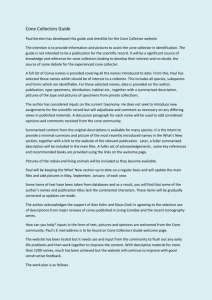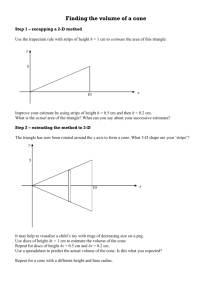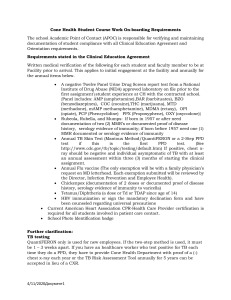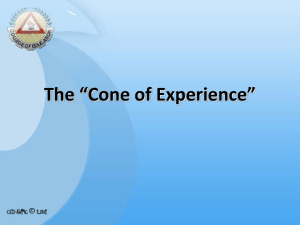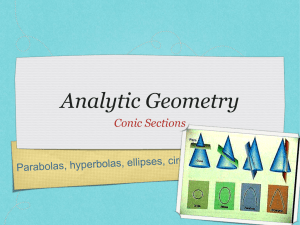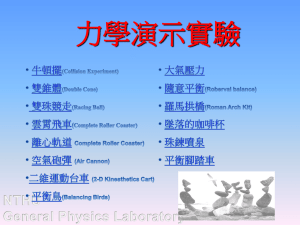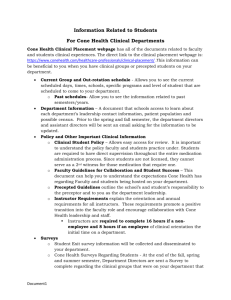4 molecules of Life: We are reverse Plants
advertisement
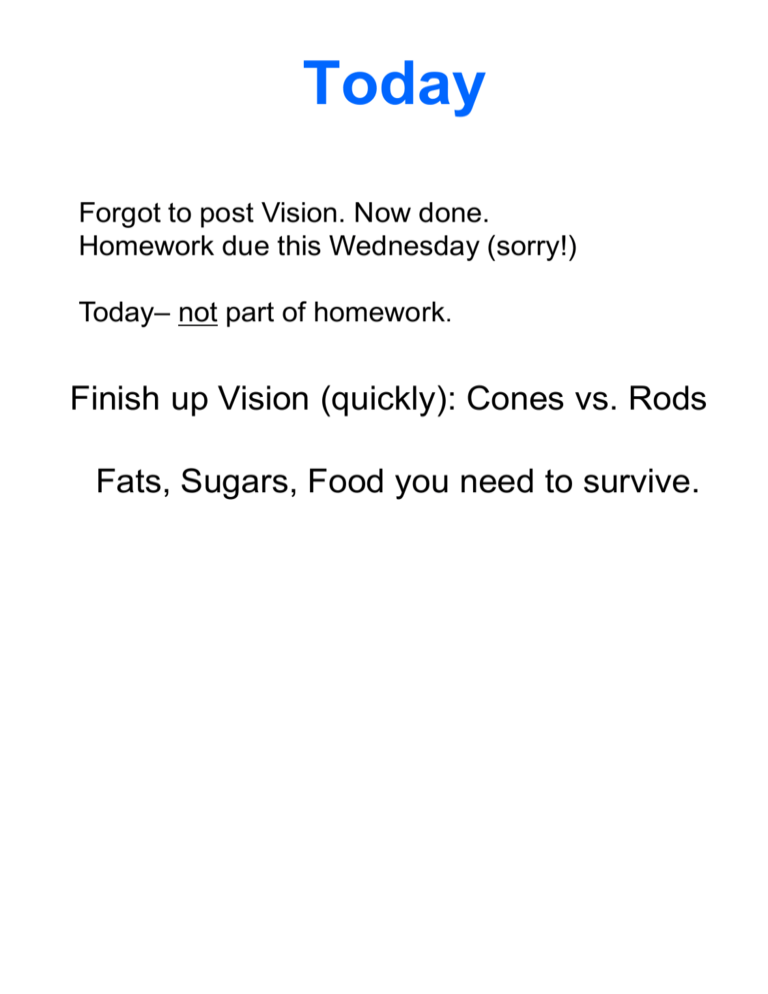
Today Forgot to post Vision. Now done. Homework due this Wednesday (sorry!) Today– not part of homework. Finish up Vision (quickly): Cones vs. Rods Fats, Sugars, Food you need to survive. light 5. Rods and Cone Backwards! Cis trans - retinal • Rhodopsin molecules contain a protein called opsin plus a derivative of vitamin A called 11-cis-retinal. In the dark, 11-cis-retinal fits nicely into the folds of the surrounding opsin. When light hits the rhodopsin, the 11-cis-retinal becomes alltrans-retinal and no longer fits into the cavity of opsin. The opsin and the all-transretinal separate. [Ultimately, the all-trans-retinal molecule is expelled from the protein, yielding free opsin plus free all-trans-retinal.] The change in rhodopsin conformation is eventually transmitted to the nerve cells in the eye and then the brain. The stereoisomerism of retinal is thus an important part of the vision process. Note that only one of the five double bonds is affected in this transformation, but when this one changes from cis to trans, the shape of the entire molecule changes. An enzyme later catalyzes the change of all-trans-retinal back to 11-cis-retinal so that it can once again bind opsin and wait for the next exposure to light. http://www.chemistry.wustl.edu/~edudev/LabTut orials/Vision/Vision.html http://www.brookscole.com/chemistry_d/templat es/student_resources/0030012910_kotz/oscien ce/ch11/carbon4.html GMP cGMP 6. cGMP required to open Na+ channels. Therefore Ligand-gated Na+ and Ca2+ close. Notice that ion channel is Metabotropic—change in response goes through a secondary messenger 7. Action Potential decreases http://www.chemistry.wustl.edu/~edudev/LabTut orials/Vision/Vision.html#Signal Color Vision—Cone Cells Color vision in the cone cells operates by essentially the same process as the monochrome vision in the rod cells. However, whereas the eye only has one type of rod cell, the eye has three different types of cone cells. The differences between the three types of cone cells, allow us to distinguish colors. Every color in the visible spectrum can be made by a mixture of the three primary colors recognized by the three types of cone cells. Each type of cone cell contains a different protein bound to 11-cis-retinal and has its own characteristic absorption spectrum, corresponding to the particular pigment protein that it contains. Goldfish red-, green- and blue-absorbing pigments Only a few amino acids differ in retinal which is sensitive to blue, green & red. http://www.chemistry.wustl.edu/~edudev/LabTu torials/Vision/Vision.html#Signal Rods and Cones Sharpness & Sensitivity Rods are very sensitive to light —seeing about a single photon. Cones are not as sensitive — but are useful for differentiating color — create sharper images. Why is this? Brain reads from optic nerve, which differentially takes signals from rods and cones. Each cone connects to a single nerve. Brain can tell exactly where light came from, i.e. extremely sharp image. Each rod may share a nerve with 10,000 other rods. Less sharp. Yet more sensitive (?). Thus, our ability to view images depends on the brain determining the location of the photoreceptor cell that passes an impulse to any given nerve fiber. http://www.chemistry.wustl.edu/~edudev/LabTu torials/Vision/Vision.html#Signal Color Perception Diff. Animals • Perception of color is achieved in mammals. In most primates closely related to humans there are three types of cone cells, although up to 10% of women have tetrachromacy! • Nocturnal mammals: less-developed color vision. • Honey- and bumblebees have trichromatic color vision, which is insensitive to red but sensitive in ultraviolet to a color called bee purple. •Tropical fish and birds, may have more complex color vision systems than humans. In the latter example, tetrachromacy is achieved through up to four cone types, depending on species. •Many other primates and other mammals are dichromats, and many mammals have little or no color vision. Marine mammals: a single cone type and are thus monochromats. •Pigeons are likely pentachromats. Many invertebrates have color vision. Papilio butterflies apparently have tetrachromatic color vision despite possessing six photoreceptor types. The most complex color vision system in animal kingdom has been found in stomatopods with up to 12 different spectral receptor types which are thought to work as multiple dichromatic units. Evolution: herbivore primates Search for flowering plants Wikepedia From Atoms to molecules to macromolecules to you! 3-6 elements make up majority of you. About 3 dozen organic compound -- precursors of almost all biomolecules Body (Cell) uses 4 types of small molecules 1. Amino acids– make up proteins 2. Nucleic acids—DNA, RNA 3. Fatty acids/Lipids-- membranes 4.Sugars/polysaccharides/Carbohydrates— structural, food What does body/cell uses 4 molecules for? 1. Building blocks 2. Energy Source 3. Information Primarily made of 4 small molecules H2CHRCOOH: R= 1 or 20 side groups Minimal Requirements of Food A complete diet must supply the elements; carbon, hydrogen, oxygen, nitrogen, phosphorus, sulfur, and at least 18 other inorganic elements. The major elements are supplied in carbohydrates, lipids, and protein. In addition, at least 17 vitamins and water are necessary. If an essential nutrient is omitted from the diet, certain deficiency symptoms appear. http://www.elmhurst.edu/~chm/vchembook/5900verviewmet.html Little ATP but takes energy from NAD, FAD Lots of ATP 1 Glucose ≈ 30 ATP Amino Acids 1. Building blocks -- Make proteins 2. Energy Source -- Eat proteins 3. Information -- Signaling between cells/nerves Example of amino acid breakdown Proteins, sugar Pyruvate ATP Sugars = Carbohydrates 1. Building blocks -- Make complex sugars… glucose, glycogen (polymer of glucose Holds your cells together--Extracellular space filled with sugars Cellulose (if a plant) 2. Energy Source -- Eat Hershey’s chocolate! Glucose makes 30-40 ATPs 3. Information -- A lot! Much information. Signaling that you are different than a pig. Carbohydrates Sugar is a carbohydrate (C + H2O) Sucrose & Lactose broken down into Glucose then into Pyruvate and then into ATP as energy. With Enzyme can digest! If no Enzyme can’t digest! Fatty Acids/ Lipids (Lipid– not dissolve in water) Carboxylic acid with an aliphatic tail hydrophobic hydrophilic 1. Building blocks -- Make membranes. 2. Energy Source -- Eat fat 3. Information -- Signaling that you are different than a pig. Definition of Fatty Acids Fatty Acids & Fat Fat = Energy Source hydrophilic hydrophobic Lipids—low dielectric constant, excludes Ions, used a lot. Class evaluation 1. What was the most interesting thing you learned in class today? 2. What are you confused about? 3. Related to today’s subject, what would you like to know more about? 4. Any helpful comments. Answer, and turn in at the end of class. C3 –high energy C2 –high energy pyruvate Glucose pyruvate + 2ATP (in cytoplasm) Acetyl CoA mitochondria 2 ATP + NADH + FADH2 mitochondria 30 (34 max) ATP Acetyl-Coenzyme A The three major carbohydrate energy producing reactions are glycolysis, the citric acid cycle, and the electron transport chain. Animated Glycolysis http://www.johnkyrk.com/glycolysis.html Multiple steps to get ATP and reduced NADP (NADPH) to enter the (Citric acid =) Krebs cycle in mitochondria to get more ATP. If you were a biochemist, you’d have to know all of the steps! Aren’t you lucky that you don’t have to know them! Interesting Details about Energy Storage

